Chartbook #2:
Racial and Ethnic Differences in Health 1996
By Barbara L. Kass, M.P.H., C.H.E.S., Robin M. Weinick, Ph.D., Alan C. Monheit, Ph.D.
Contents
Executive Summary
This report presents estimates of health insurance coverage, access to health care, and health status for Hispanic, black, and white Americans. Key findings include:
Health insurance
Hispanics of all ages were the most likely to be uninsured. Nearly 3 in 10 Hispanic children had no insurance coverage. Hispanics were the least likely to get private health insurance through their jobs. In particular, Hispanic male workers were far less likely than other workers to have job-related health coverage. Blacks were less likely than whites to have private health insurance. However, they were the group most likely to be publicly insured.
Access to care
Hispanics were the least likely to have a usual source of health care. Blacks and Hispanics were more likely than others to have a hospital-based usual source of care. Families headed by Hispanics were the most likely to report barriers to obtaining the health care they needed.
Health status
Return To Table Of Contents
Introduction
Despite many recent improvements in the health of Americans, substantial differences still exist between racial and ethnic groups. These differences are the focus of considerable public attention, and in 1998 the Clinton Administration announced a new national effort to eliminate racial and ethnic gaps in Americans' health (the Initiative to Eliminate Racial and Ethnic Disparities in Health).
Differences in the health of racial and ethnic groups may result from differences in their experiences with our health care system. This report focuses on three key aspects of racial and ethnic differences in health and health care. The first section presents data on the health insurance status of black, Hispanic, and white Americans. Since health insurance is just one of the factors that may influence racial and ethnic differences in health, the second section of the report addresses access to health care, described in terms of usual sources of care and barriers to care. Finally, the third section turns to the motivating force behind our Nation's interest in this topic: differences in health status among American racial and ethnic groups.
Return To Table Of Contents
Source of Data for This Report
The estimates presented in this report are drawn from the Medical Expenditure Panel Survey (MEPS). MEPS is the third in a series of medical expenditure surveys conducted by the Agency for Health Care Policy and Research. It is a nationally representative survey that collects detailed information on health status, health care use and expenses, and health insurance coverage of individuals and families in the United States.
These data come from the first and second rounds of interviewing for the Household Component of the 1996 panel of MEPS. (See
Note 1.) The estimates presented here are nationally representative of the civilian noninstitutionalized population. MEPS data are released to the public in a number of formats, including public use data files and the printed MEPS Research Findings and MEPS Highlights series. The numbers shown in this chartbook are drawn from a variety of the Research Findings reports as well as additional analyses conducted by the MEPS staff. Specific sources for the information presented here are listed in the references section.
In some cases, totals may not add precisely to 100 percent as a consequence of rounding. The racial category "white/other," used in some charts, includes a number of individuals identified as Asians, American Indians, Aleuts, Eskimos, or other races. The health of these groups is of interest, but MEPS includes too few individuals to present data on them. Unless otherwise noted, only differences that are statistically significant at the 0.05 level are discussed in the text.
Return To Table Of Contents
Section 1: Health Insurance
Health insurance plays a critical role in ensuring that Americans obtain timely medical care and have protection against expensive health care costs. This section describes the health insurance coverage of various racial and ethnic groups. MEPS groups health insurance into three categories. Those people grouped as "any private" had private health insurance at any time during the study. For example, people who had health care coverage from their workplace for 1 month would be considered privately insured. People who had no private coverage at any time during the study but who had public insurance such as Medicaid or Medicare are described as "public only." People who did not have private or public insurance at any time during the study are described as "uninsured." (See Note 1.)
Return To Table Of Contents
Who has coverage and who doesn't?
Black and Hispanic Americans were more likely than whites to be uninsured. Blacks were the most likely to be publicly insured, while whites were the most likely to have private coverage.
Less than half of all Hispanics and blacks had private health insurance, compared to three-fourths of whites. Over one-fifth of all Hispanics and over one-fourth of blacks had only public insurance, compared to one-tenth of whites. Hispanics and blacks were much more likely than whites to be uninsured.
Health insurance, all ages
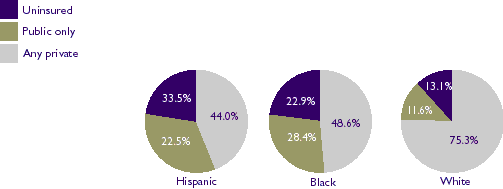
Return To Table Of Contents Are some racial and ethnic groups more likely to have job-related insurance?
Employers are the most common source of private health insurance coverage in the United States. Overall, Hispanic and black workers ages 16-64 were less likely than white workers to have job-related health insurance.
Job-related health insurance, workers ages 16-64
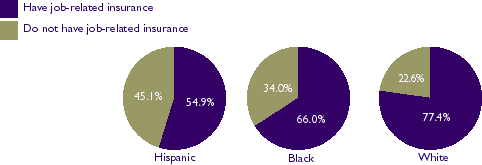
Return To Table Of Contents
Are certain racial/ethnic groups more likely to be uninsured?
Although people in the white/other group represented more than half of the uninsured population, Hispanics and blacks were disproportionately represented among the uninsured.
Hispanics represented only 11.6 percent of the U.S. population under age 65 but accounted for 21.2 percent of the uninsured population. Similarly, blacks represented 13.1 percent of the non-elderly U.S. population but 16.9 percent of the uninsured population. In contrast, the white/other group represented 75.3 percent of the non-elderly U.S. population but only 61.9 percent of the uninsured population.
Population under age 65
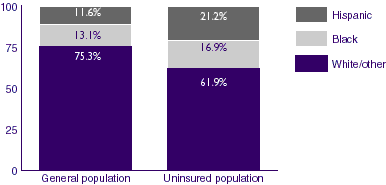
Return To Table Of Contents What is the role of gender in insurance coverage?
Gender is an important factor in the relationship between race/ethnicity and health insurance coverage.
Private insurance coverage was similar for males and females in each racial/ethnic group. Among all racial/ethnic groups, females were more likely than males to have public insurance. Hispanic males were substantially more likely to be uninsured than any other group.
Health insurance, all ages
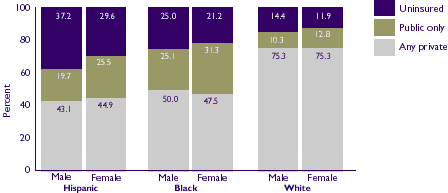
Return To Table Of Contents Is health insurance different for young adults?
Young adults ages 19-24 were the age group most likely to lack health care coverage.
About one-third of Hispanic and black young men and women had private insurance coverage. In contrast, more than 60 percent of white young adults had such coverage. Among young adults, Hispanic and black women were far more likely to be publicly insured than their male counterparts. They were also more likely than young white women to have public coverage. Among young adults of both sexes, Hispanics and blacks were more likely than their white counterparts to be uninsured.
Health insurance, ages 19-24
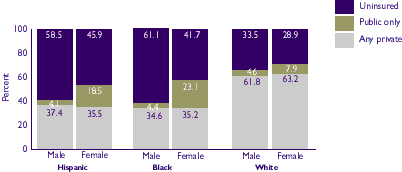
Return To Table Of Contents Are there gender differences in job-related health insurance among racial/ethnic groups?
Hispanic male workers were far less likely than all other workers to have health coverage from an employer. Only half of Hispanic male workers obtained job-related health coverage, compared with two-thirds of black male workers and three-quarters of white male workers. Hispanic female workers were much more likely than Hispanic male workers to have job-related coverage. White female workers were more likely than their Hispanic or black counterparts to have job-related health coverage.
Percent with job-related health insurance, workers ages
16-64
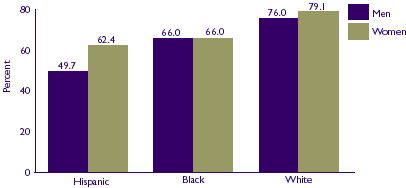
Return To Table Of Contents Are children in certain racial/ethnic groups more likely to lack health insurance?
Hispanic children were the most likely to be uninsured. They were more than twice as likely as white children to have no insurance coverage. White children were far more likely than either black or Hispanic children to have private health insurance. Black children were the most likely to have public health care coverage (40.8 percent), followed by Hispanic (32.5 percent) and white (13.1 percent) children.
Health insurance, children under age 18
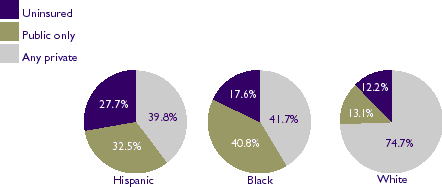
Return To Table Of Contents
Section 2: Access to Health Care
Adequate access to health care services can significantly
influence health care use and health outcomes. One way to measure access to care
is to ask whether people have a usual source of care—a person or place they
usually go to if they are sick or need advice about their health. Lacking a
usual source of care may also have important implications for the quality and
continuity of care received. In addition, even people who have a usual source of
care may experience barriers to receiving services because of financial or
insurance restrictions, lack of availability of providers at night or on
weekends, or other difficulties.
This section describes racial and ethnic differences in
usual sources of care and barriers to obtaining needed health care.
Return To Table Of Contents Are different racial/ethnic groups less likely to have a
usual source of care?
Hispanic and black Americans were substantially less likely
than other Americans to have a usual source of health care.
Hispanics were the least likely to have a usual source
of care. Over three-fourths of the white/other group (76.3
percent) had an office-based usual source of care, compared with 57.9
percent of Hispanics and 63.6 percent of blacks. Blacks and Hispanics were more likely than the
white/other group to have a hospital-based usual source of care.
Usual source of care, all ages
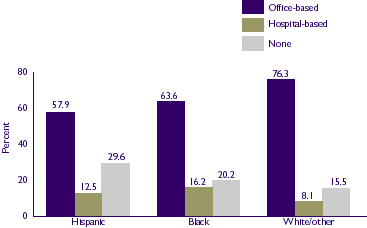
Return To Table Of Contents Are children in some racial/ethnic groups more likely to
be without a usual source of care?
Hispanic and black children were less likely than white
children both to have a usual source of care and to have an office-based source
of care.
Hispanic children were less likely than children in any
other racial/ethnic group to have a usual source of health care. Black children were twice as likely as white children
to have no usual source of health care. Hispanic and black children were less likely than white
children to have an office-based usual source of care and were more likely
to have a hospital-based source of care.
Usual source of care, children under age 18
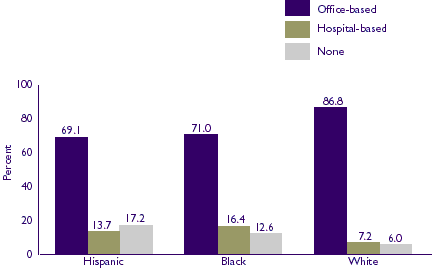
Return To Table Of Contents Are certain racial/ethnic groups more likely to face
barriers to receiving health care?
Families headed by Hispanics were the most likely to report
having difficulty, delaying, or not receiving health care they needed.
Percent of families with barriers to obtaining needed
health care
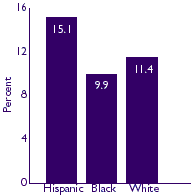
Return To Table Of Contents What types of health care barriers do different
racial/ethnic groups experience?
Among families that encountered problems in receiving care,
those headed by Hispanics (69.1 percent) were more likely than those headed by
persons in the white/other group (58.5 percent) to be unable to afford health
care.
Main problem encountered by families with barriers to
care
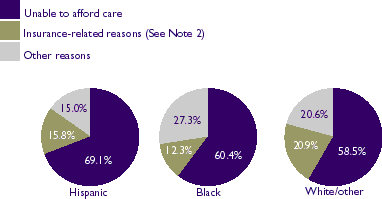
Return To Table Of Contents
Section 3: Health Status
President Clinton's Initiative on Race calls for
eliminating racial and ethnic disparities in selected health problems by the
year 2010. As stated in the Initiative, the health of Americans overall has
improved over the past 5 years. However, blacks and Hispanics are still more
likely than white Americans to report that they have poor health.
Answers to simple questions like the one reported here,
which asked, "Would you rate this person's health as excellent, very good,
good, fair, or poor?" have been shown to predict both demand for medical
care services and medical outcomes.
Return To Table Of Contents Does health status differ between racial/ethnic groups?
Hispanics and blacks were more likely than whites to be
in fair or poor health. Over 17 percent of Hispanics and 16 percent of
blacks were in fair or poor health, as compared with less than 10 percent of
whites. Hispanics and blacks were less likely than whites to be
in excellent health.
Health status, ages 18-64
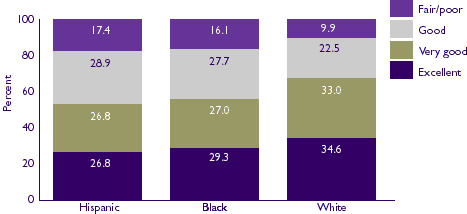
Return To Table Of Contents What is the role of gender in health status?
Fair or poor health was more common among Hispanics and
blacks than among whites for both males and females. Females within each racial/ethnic group were more
likely than their male counterparts to be in fair or poor health.
Percent in fair or poor health, all ages
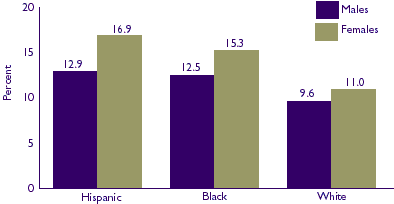
Return To Table Of Contents Are children in different racial/ethnic groups at greater
risk of being in poor health?
Hispanic children were the most likely to be in fair or
poor health. Black and Hispanic children were less likely than white
children to be in excellent health. Just over 55 percent of white children
were in excellent health, compared to approximately 43 percent of Hispanic
and 48 percent of black children.
Health status, children under age 18
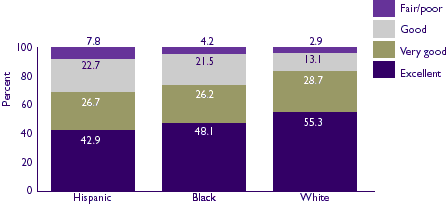
Return To Table Of Contents Conclusions
The data presented in this report suggest that Hispanic
and black Americans are more likely than white Americans to:
Lack private job-related health insurance coverage. Be uninsured. Lack a usual source of care. Have a hospital-based usual source of care. Be in fair or poor health.
These data provide a snapshot of racial and ethnic
disparities in a variety of measures of health in 1996. Future MEPS data can be
used to follow trends in these measures over time, as well as to provide
additional information on racial and ethnic disparities in health.
Return To Table Of Contents
Looking Ahead: Future MEPS Data This report presents estimates of children's health
insurance coverage, access to health care, and health status. Future data from
MEPS will address a number of additional aspects of children's health care,
including:
The impact of managed care. Use of specific services. Use of preventive health services. Amounts paid for health care and sources of payment. Additional measures of health status, including health
conditions and functional limitations. Amounts families pay for private health insurance
coverage.
MEPS is a unique data resource for monitoring our Nation's
health care system. As an ongoing survey, MEPS will produce data that can be
used to examine changes over time.
Return To Table Of Contents
References
The following references served as source material for
this chartbook. Each reference shows in parentheses the chartbook pages derived
from that source.
Monheit AC, Vistnes JP. Health insurance status of workers
and their families: 1996. Rockville (MD): Agency for Health Care Policy and
Research; 1997. MEPS Research Findings No. 2. AHRQ Pub. No. 97-0065. (Chartbook
pages 7 and 11)
Vistnes JP, Monheit AC. Health insurance status of the
civilian noninstitutionalized population: 1996. Rockville (MD): Agency for
Health Care Policy and Research; 1997. MEPS Research Findings No. 1. AHRQ
Pub. No. 97-0030. (Chartbook pages 6, 8, 9, and 10)
Weigers M, Drilea SK. Perceived health status and
functional limitations among minorities: a comparison of Hispanics, blacks, and
whites. Rockville (MD): Agency for Health Care Policy and Research; 1999
(forthcoming). MEPS Research Findings. (Chartbook pages 20 and 21)
Weinick RM, Weigers ME, Cohen JW. Children's health
insurance, access to care, and health status: new findings. Health Affairs
1998;17:127-136. (Chartbook pages 12, 15, and 22)
Weinick RM, Zuvekas SH, Drilea SK. Access to health
care—sources and barriers, 1996. Rockville (MD): Agency for Health Care Policy
and Research; 1997. MEPS Research Findings No. 3. AHRQ Pub. No. 98-0001.
(Chartbook pages 14, 16, and 17)
Please consult the MEPS Web site at http://www.meps.ahrq.gov
for an updated publications list or additional copies of this publication.
Return To Table Of Contents Notes
Note 1: Data collection for
Round 1 took place from March through July 1996 and asked about health-related
issues for the period from January 1, 1996, to the date of the Round 1
interview. Round 2 data collection occurred during the period from August to
November 1996 and asked survey respondents to report on health-related issues
between the date of the first interview and the date of the second interview.
All data concerning health insurance, health status, and demographics presented
in this chartbook come from Round 1 of the survey. Health insurance and health
status estimates should therefore be interpreted as estimates for experiences
during the first half of 1996. Information on access to care was obtained in
Round 2 of the survey; however, the questions on access to care generally did
not ask about a specific time period.
Note 2: Insurance-related
reasons include "insurance company wouldn't approve, cover, or pay for
care," "pre-existing condition," "insurance required a
referral but couldn't get one," and "doctor refused to accept family's
insurance plan."
Return To Table Of Contents
Suggested Citation:
Chartbook #2: Racial and Ethnic Differences in Health 1996. February 1999. Agency for Healthcare Research and Quality, Rockville, MD.
http://www.meps.ahrq.gov/data_files/publications/cb2/cb2.shtml |
|
